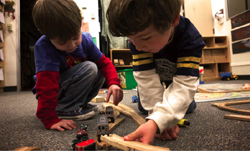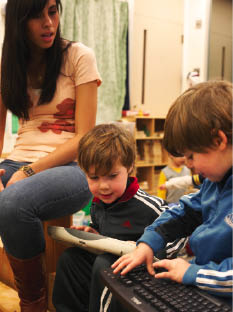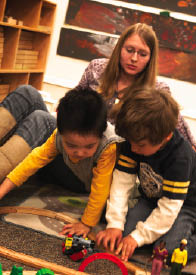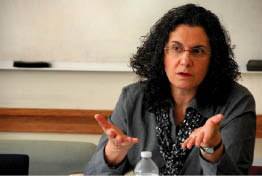The Play is the Thing
At TC's Rita Gold Center, imagination is the curriculum
At TC’s Rita Gold Center, imagination is the curriculum
by Jonathan Sapers
Every day in the preschool room at TC’s Rita Gold Early Childhood Center, Michael and Timmy assemble a spaceship from wooden blocks, with higher seats for grownups and lower ones for children.
One morning last fall, Eileen Blanco, a graduate assistant, joined the boys on board for a spirited count-down to launch.
“Where are we going?” she asked in the quiet after blast-off.
“Jupiter,” said one of the boys, who are fraternal twins.
Blanco briefly stepped out into the void to retrieve a book on space.
“Did you know that in parts of Jupiter, the temperature is 43,000 degrees?” she asks.
The boys considered this information gravely.
“Well, that’s okay,” Michael said. “Our spaceship has fans.”
“Reimagining the possible” at TC is an important theme in the College’s Integrated Early Childhood Program, which certifies teachers to work with children from birth to second grade in both general and special education settings. At the preschool level, as demonstrated at the Rita Gold Center, the operative philosophy is play-based teaching.
“Dramatic play is so important,” says Monika Soroka, another Early Childhood student who, like Blanco, was doing her practica last year at Rita Gold, one of the program’s many sites for field placements. (Students also work in general education, special education and inclusive settings at a variety of private and public schools in the City, but nearly everyone gets a semester at the Gold Center.) “The adult will ask things that get the children to think, like ‘Where are we going?’ And ‘How are we getting there?’ With children this age, who are evolving so quickly, it’s language development and social skills and emotional growth all happening together.”
“There’s really a big role that teachers play in creating the kind of environment that fosters creativity—but to do that, they must become very good observers of the children,” says Susan Recchia, Associate Professor of Education, who co-coordinates the Integrated Early Childhood Program along with Professor of Education Celia Genishi, and who is also the Gold Center’s faculty director. Recchia calls the Center’s play-based approach the “emergent curriculum,” meaning that what is taught grows out of the play itself. “Teachers must watch to see what the children are interested in, what ideas they’re bringing to the group, and how they’re engaging. Then they try to respond and capitalize on those ideas. Sometimes it’s just the smallest response that will get a kid going and keep her going. Sometimes it’s bringing in an additional material or activity at just the right moment.”
Last spring, for example, after the children in the class started talking about buildings, the teachers helped them look at buildings on the Internet. Then they began drawing buildings. Someone mentioned the Little Red Lighthouse, the lighthouse under the George Washington Bridge that was immortalized in the 1942 children’s book The Little Red Lighthouse and The Great Gray Bridge. Soon the teachers were reading the book to the class. That led to an actual field trip, which was followed by the building of a Little Red Lighthouse model, which led to building a model of the bridge, too.
The give-and-take keeps everyone on their toes, Recchia says.
“Ultimately, it’s a combination of the kids saying, ‘What about this?’ and then one of the teachers being ready to say, ‘Oh, yeah, let’s learn more about it.’”
Learning from the students
The Rita Gold Center curriculum draws on a variety of sources, but at the heart of it, Recchia says, are “constructivist approaches to education and creating environments that promote children’s learning”—basically, allowing children the freedom to explore and discover, challenge themselves, make mistakes and learn from the things that they do.
At a time when America is bemoaning a loss of creative thinking, the Center and the program require teachers to not only respect but actively learn from children’s ideas and —perhaps even more so—from their creative process. It’s an ethos inspired by the experience of “Reggio Emilia,” a precursor of the emergent curriculum method named for the northern Italian town where it was developed after World War II.
“The whole town embraced early childhood education for its children,” Recchia says. “It’s a little bit different than how things tend to work in this country. The ideas are very powerful, that children themselves are given the opportunity to discover, to use all kinds of materials in creative ways, to think outside the box.”
The Integrated Early Childhood program, in turn, seeks to foster that same ability in teachers.
“How do you become an early childhood teacher? How do you become somebody who specializes in young children and in working with children with special needs?” Recchia asks. “We’re Teachers College, so our students read a lot of theory and do a lot of assignments and have a lot of discussion in class, but there’s nothing that takes the place of an in-the-moment, hands-on, face-to-face with a three-year-old.”
Certainly the program is not all the result of spontaneity. The 15 to 20 student teachers who work with the Gold Center’s 40 children each semester constantly record and discuss what the children are doing. In the preschool room, where Blanco and Soroka worked, the observations are written on clipboards that hang on a bookcase in the classroom, available for parents to read every day at pick-up time. The record-keeping not only helps the teachers and students map the children’s progress towards developmental goals, it also gives the students training in communication with parents and in writing to the formal record, both crucial skills for teachers.
Nor are students asked to simply get out there and wing it. They work with seasoned teachers, many of whom—particularly at the Gold Center—are themselves graduates of the Integrated Early Childhood program.
“There is a kind of apprenticeship that happens with our practicum students who take part in the classroom,” Recchia says. “But the apprenticeship includes gradually giving them more opportunities to be the one who’s leading the meeting, or taking charge of a particular project. It’s really learning by doing.”
Indeed, the aspiring teachers in the early childhood program go through what is essentially their own emergent curriculum at the Rita Gold Center.
“It can be very confusing for our students at first, because we start by having them simply come in and watch,” Recchia says. “And that can be uncomfortable, because the prevailing image of the teacher in our society is of someone who is always leading, always structuring. So we try to get students to understand the importance of the observational piece and that there are many ways to be actively present and responsive to children without directly instructing them.”
The practicum students keep journals about themselves and their own experiences, sending thoughts and questions to their instructors every week. The process is informal and open-ended, but the instructors’ feedback often directly influences how students think on their feet in the classroom.
Blanco and Soroka, whose practica were overseen by Recchia, met with her once a week in a senior seminar, during which they also reviewed results of research they were conducting.
Blanco was looking into the role of the Special Education Itinerant Teacher (SEIT)—a visiting specialist who works with children with disabilities—and, more specifically, how the SEIT collaborates with the preschool room’s teaching staff. Soroka, for her part, studied Michael and Timmy, who comprised one of the class’s two sets of twins. Over the course of her research, she became interested in the boys’ relationships with each other and their peers—including ways each twin established his own identity.
“I’m seeing more of who does what now,” Soroka reported during a seminar meeting. “One of the boys has started counting from eight down to zero. And the other one wasn’t around, and I said, ‘Wow, that’s huge. Your brother is not taking the credit—it’s not you both building the space shuttle. It’s just you.’”
Recchia, who had corresponded with Soroka about this interest, prodded her to continue focusing on instances in which the twins were seen as individuals by their parents, their babysitter and their teachers.
“I have a real interest in this topic, too, because my youngest siblings are twins, a girl and a boy,” Recchia said, drawing Soroka out. “Even now, when we talk about them, we often just call them ‘the twins,’ we don’t even say their names. They’re stuck with each other. The world sees them as a unit.”
Primary Colors
Recognizing who children really are is another focus of the curriculum, one that springs directly from the notion of creativity and play, but—as one might expect from a program that incorporates multiculturalism and working with children with diverse abilities—speaks to broader issues of social justice, as well.
“We’re always pushing students to question what’s appropriate, what’s fair, what’s right. How do some students get marginalized in the system? And what do we do about that?” Recchia says.
That emphasis attracted Soroka, an immigrant from Poland and a product of the New York City public school system who grew up in an underprivileged neighborhood in Brooklyn. “The whole social justice philosophy is very much in the atmosphere here,” she says. “We treat the children as individuals. We don’t laugh at their comments, but instead try to build on whatever they’re saying so they feel valued as a part of the community.”
Blanco, too, likes the way the program encourages an awareness of multiple perspectives. Last year, she and another teacher took a group of children to a toy store to pick out dolls to donate to a kindergarten classroom that included a significant number of African American and Latino girls. When Blanco, herself Latina, suggested that the kindergarteners might prefer dolls with darker skin, a lighter-skinned child in her group objected, insisting instead on a blonde doll.
“I was caught off guard,” Blanco says. “So we took a vote.”
A split decision resulted, and two dolls were purchased —the blonde doll and one with darker skin. Later, Blanco replayed the moment with Mariana Souto-Manning, a TC faculty member who teaches the program’s course “Multicultural Approaches to Teaching Young Children.”
“She was really supportive,” Blanco says. “She said, ‘I think you did a great job, you did what you could in the heat of the moment, and here are some different ways to expand on it in the classroom. If the child brings it up again, it’s not something you should shy away from just because you may get uncomfortable. It’s a real thought, and we need to help her process some of her thoughts and ideas so they don’t end up confusing her later on.’”
After also discussing the incident with Recchia, Blanco says she and her co-teachers further diversified the doll population in their own classroom and made sure to highlight books on diversity from the classroom library. “I don’t know if it was just an odd moment for the little girl,” she says of what happened at the store. “Because later we brought in a dark-skinned doll with black hair, and she played with that doll and didn’t think twice.”
For Recchia, the incident was a classic teachable moment. “I think it’s a great example of the ways that young children begin to form ideas very early on about what they are comfortable with, what seems and feels ‘right’ and ‘good’ to them, and the role that teachers can play in helping broaden children’s perspectives.”
The notion of fairness is one that translates fairly easily to children, Recchia says. “It’s a concept that really resonates with them, and many opportunities emerge in the day-to-day activities of the classroom to help them negotiate their understanding of it and their ways of responding to each other around it.”
The goal isn’t to homogenize, but instead to emphasize difference as something to be respected and valued because —like creative thinking itself—it might take things in unexpected directions.
“Our approach is more one of helping children see that we are all different—some people want a turn and others might not. We try to create a school environment that makes room for different kinds of choices and ways of being, and that gives every child a chance to be heard.”
Published Wednesday, Dec. 15, 2010



